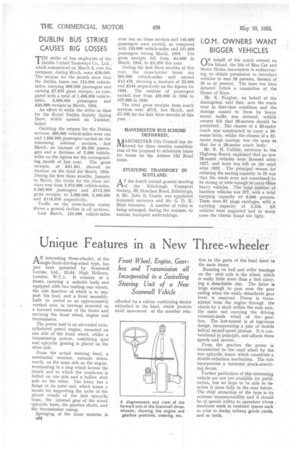Unique Features in a New Three-wheeler
Page 122

If you've noticed an error in this article please click here to report it so we can fix it.
Front Wheel, Engine, Gearbox and Transmission all Incorporated in a Swivelling Steering Unit of a New Scammell Vehicle
AN interesting three-wheeler, of the single-front-driving-wheel type, has just been patented by Scammell Lorries, Ltd., 52-54, High Holborn, London, W.C.1. It consists of a frame, carrying a suitable body and equipped with two trailing rear wheels, the sole function -of, which is to support the load, and a front assembly, built to swivel on an approximately vertical axis, in bearings mounted on a forward extension of the frame and carrying the front wheel, engine and transmission.
The power unit is an air-cooled twincylindered petrol engine, mounted on one side of the front wheel, whilst a transmission system, combining spur and epicyclic gearing is placed on the other side.
From the actual steering head, a substantial member, extends downwards, on the same side as the engine, terminating in a ring which houses the clutch and . to which the crankcase is bolted on one side and a hollow stub axle on the other. The latter has a flange at its outer end, which forms a means for supporting the axles of the planet wheels of the first epicyclic train, the internal gear of the scond epicyclic train, the gearbox shafts, and the transmission casing.
Springing of the front member is c64
tive to the parts of the. head fixed to the main frame.
Running on ball and roller bearings on the stub axle is the wheel, which is really little more than a hub carrying a detachable rim. The latter is large enough to pass over the gear casing when the easily detachable gear lever is removed. Power is transmitted from the engine through the clutch by a shaft within the stub axle, the outer end carrying the driving constant-mesh wheel of the gearbox. The last-named is of ingenious design, incorporating a pair of double helical second-speed pinions. It is conventional in principle, and affords three speeds and reverse.
From the gearbox the power is transmitted -to the road wheel by the two epicyclic trains which constitute a double-reduction mechanism. The hub incorporates a torsional shock-absorbing device.
Further particulars of this interesting vehicle are not -yet available for publi-. cation, but we hope to be able to describe it more fully in the near future. The chief attraction of the type is its extreme manceuvrability and it should be of special utility to operators whose machines work in confined spaces such as arise in docks, railway goods yards, and so forth.




































































































































































